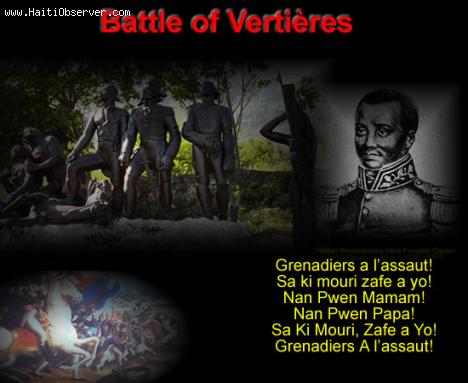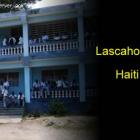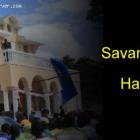ADVERTISEMENT
Cap-Haitian - Haiti Observer Blog
Cap-Haitian, Haiti Observer Blog. Read the following articles about Cap-Haitian
The Battle Of Vertieres
The battle of Vertieres near Cap-Haitian was motivated by slaves who hat the condition under which they have been living.
Napoleon was confident that slavery would be reestablished in Saint-Domingue. General Rochambeau, who succeeded Leclerc as commander of the French army in Saint-Domingue, started implementing a series of atrocities including mass hangings and drowning of slaves suspected to be involved in insurrections.
Dessalines relentlessly attacks one town after another. He started in the South of the Country with Cayes, then Jacmel, Léogane, Jérémie, Saint Marc and Port-au-Prince. These actually set the stage for the assault on le Cap Français in the last great battle of independence in Vertieres.
Vertieres, Near Cap-Haitian, Site of Last Battle Before Haiti independence
This was the last battle of the Expedition Santo Domingo. The battle took place in Vertières Vertières near Cap Francais, now known as Cap-Haitian. It involves a troop commanded by General Rochambeau for the French Colonizer and General Jean-Jacques Dessalines, leader of the slave rebellion.
On November 18, 1803 , Jean-Jacques Dessalines ordered François Capois (Capois lamort) Brigade to take Fort Vertières, located on a hill near the city of Cap-Haitian. Capois raised several unsuccessful attempts by had to go back due to heavy fire from the fort.
After the third attempts where many of his forces received many casualties, Capois-La-Mort asked his force to follow him, shouting: "Forward! Forward". At one point, his horse was hit by a cannon and fell, but Capois took his sword, stood up and ran again to the head of his soldiers shouting always "Forward! Forward".
Barriere Bouteille in Cap-Haitian Painted in Pink, falling into Political Propaganda
Barriere Bouteille or the three Booths at southern entrance of Cap-Haitian were found painted in pink which is the official color of the government of Michel Martelly.
What is next?
Will we see soon a new and improved pink Citadelle Laferrière? while we are at it, why not the Sans Souci Palace?
According to some witnesses, they woke up one day and saw the three booths of Barriere Bouteille painted in pink with no explanation what so ever.
Moun Okap Kote nou Ye!
Cap-Haitien, Limonade and Quartier-Morin flooded
On the night between Thursday, November 8 and Friday November 9, 2012 heavy rains poured for in the North Department causing lost of several lives as well as damages to homes and agriculture.
The cities and towns most affected include: Cap-Haïtien, Limonade and Quartier-Morin. It was also reported that some towns in Nippes Departments were affected. It include Baradères, de Fonds des Nègres, Miragoâne, Petit-Trou, Plaisance and L'Azile.
Video:
It has been reported that about 12 people became victim of the flood so far. This is e preliminary assessment. Most of the victims lived in the beds of ravines and were surprised by the flash floods. Several people were reported missing.
Canadian sprinter Bruny Surin, born in Cap-Haitien, Haiti
Bruny Surin, a renowned Canadian sprinter, was born in Cap-Haïtien, Haïti on 12th July 1967. He was raised in Canada where his family had found residence in 1975. Though he is famous for short distance running, Bruny began his athletic career in the long jump.
He made his first outstanding performance in the mid 1994 commonwealth games in which he won gold medal in the 4x100 relay. After switching from long jump to sprinting, Bruny Surin has won several medals. In the 1995 world championship games, he won a silver medal in the 100m race. He also secured a gold medal in the 4x100m relay with the Canadian team. He added to his medals in 1996 when he won another gold medal in 4x100m relay at Atlanta.
Thousands of People in Cap-Haitian in the Street against Michel Martelly
On Friday, September 21, 2012, thousands of people took to streets in the second city of Haiti, Cap-Haitian, to demonstrate against Martelly - Lamothe government. Barricades made of tires, stones and garbage were erected in several areas of the city. Traffic was difficult in many areas and in the neighborhood of La Fossettete and Cite Lescot where the tires were burning, impossible.
The people demonstrating were throwing slogans to show their dissatisfaction with the current policy of the government. They chanted against recent increase in food price and government corruption. Some of the people in the crowd were asking for Martelly to leave the government.
A wave of Anti-government protest in in Cap-Haitian and Cayes
The population has been until recently very patient with the Haitian government. In the mean time, the Martelly - Lamothe government has been trying to get the economic engine of Haiti running but to little success so far. This week, the second largest city, Cap-Haitian, and the third largest city, Les Cayes, have demonstrated publically their frustration with the current government.
Hundreds of people took to the streets in the city of Cap-Haitian on Wednesday to protest against the deterioration of their living conditions. Some of the protesters denounced the recent behavior of the government, calling it continuous propaganda campaign
Cap-Haitian, A Fine Vacation Destination In Haiti
Cap-Haitian also known formerly as le Cap, Cap-Henri and Cap-Francais is located on Haiti's northern coast. It is the capital of the Department of Nord and is located near Milot, a historic town. It has around 190,000 inhabitants with indigenous migrants from South and Central America. During the colonial rule it was an important city where it served as the capital of the French Colony of Saint Dominigue from 1711 to 1770.
Anti Government And Revolutionary Movements
The capital was moved to Port-au-Prince. Initially, under the rule of King Henri Christophe, it was Kingdom of Northern Haiti's first capital. Infrastructure for transportation was not very good during that time. The city was destroyed by the 7th May 1842 earthquake.
Antenor Firmin's Contributions to Bioanthropology
Cap-Haitien-born Anténor Firmin was one of the earliest scholars to write on the subject of negritude. Conceivably the first anthropologist of color, he introduced the notion of human anthropology as allied with the study of racial characteristics.
During the late 1800s, a strain of thinking pervaded U.S. and European intellectual circles, arguing the African race as low on the evolutionary scale in comparison to Caucasians. The French were dominating the conversation of the African race as intellectually inferior, due to misguided assumptions of racial differences. A prominent French author, Count Arthur de Gobineau, published "Essay on the Inequality of Human Races" that posited supremacy of the Aryan people over Africans and other dark-skinned races.
Dany Toussaint, short biography
Former Haitian Police Chief, Army major and bodyguard Dany Toussaint is also a former Senator and leader of the Haitian Democratic and Reformist Movement Party. Mr. Dany Toussaint was a body guard of former Haitian President Jean-Bertrand Aristide.
Involvement In Jean Dominique case:
Dany Toussaint was named as a suspect in the 2000 murder of a radio journalist, Jean Dominique. In 2003, Former Government Commissioner Claudy Gassant made new when he requested the immunity of Senator Dany Toussaint be lifted in regard to the assassination. This request Judge Claudy Gassant to remove his immunity was nor honored by the Haitian Senate.
Our objective is to share with you news and information about Haiti and the people of Haiti. Traditions, habits and the way we were or grew are alive in this site. We highly recommend that you Subscribe to our Newsletter and also share with us some of the things that are memorable and made us unique people.


 Lascahobas, Haiti
Lascahobas, Haiti  Something to think about
Something to think about  Haitian Thanksgiving
Haitian Thanksgiving  Black Friday Shopping Season
Black Friday Shopping Season  The Town of Savanette, Haiti
The Town of Savanette, Haiti